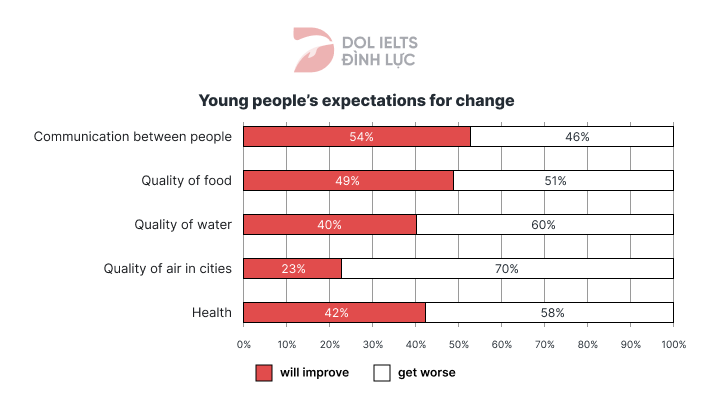akane
Oct 5, 2023
Writing Feedback / Writing task 1 Ielts: young people's expectations for change in five different areas [2]
(The chart below shows the results of a European survey into young people's expectations for change in five different areas of life in the next 20 years. They were asked if they thought things would improve or get worse.)
The statistics demonstrate how teenagers living in Europe replied to the answers to show did they agreed or not with the expectations for change in five distinct categories of life in the following two decades.
Looking from an overall perspective, it is readily apparent that people the majority show their positive toward interpersonal communication while quality of air in urban was the most pessimistic.
Regarding the chart, communication between people was thought to be better in the future, which had 54% agreement, in contrast to 46% having the opposite view. On the contrary, the quality of food would have an adverse shift in the next 20 years. Its percentage of negative expectations slightly overweighed with other thoughts, at 51% versus 49%. The quality of food also had the same expectations. The percentage of young people's agreement accounted for 40% which was 20% lower than the opposite side.
The pattern was fairly similar for the quality of air in the city. Only 23% of people believed that the air would be enhanced. Having the same view, 42% of people answered with optimistic views about health.
young people's expectations for change
(The chart below shows the results of a European survey into young people's expectations for change in five different areas of life in the next 20 years. They were asked if they thought things would improve or get worse.)
The statistics demonstrate how teenagers living in Europe replied to the answers to show did they agreed or not with the expectations for change in five distinct categories of life in the following two decades.
Looking from an overall perspective, it is readily apparent that people the majority show their positive toward interpersonal communication while quality of air in urban was the most pessimistic.
Regarding the chart, communication between people was thought to be better in the future, which had 54% agreement, in contrast to 46% having the opposite view. On the contrary, the quality of food would have an adverse shift in the next 20 years. Its percentage of negative expectations slightly overweighed with other thoughts, at 51% versus 49%. The quality of food also had the same expectations. The percentage of young people's agreement accounted for 40% which was 20% lower than the opposite side.
The pattern was fairly similar for the quality of air in the city. Only 23% of people believed that the air would be enhanced. Having the same view, 42% of people answered with optimistic views about health.

(The chart below shows the results of a European survey into young people's expectations for change
